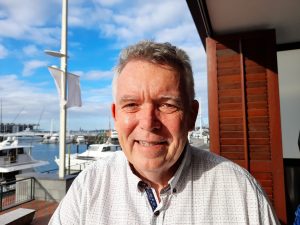Steel industry leading the charge into the next industrial revolution
Q & A Wayne Carson, Managing Director, D & H Steel…December issue NZ Manufacturer.
D&H Steel is one of the oldest and most respected steel fabricators in New Zealand. It is behind some of the largest projects in the country including Auckland Airport, Deloitte Tower, Viaduct Event Centre, and the Kopu River Bridge.
In a sector that is constantly changing to meet the latest technological advances, D&H Steel is an industry leader.
From an early adopter of welded beams to the latest ISO standards, the company has placed innovation at the heart of its business.
 HERA spoke to Managing Director, Wayne Carson, about the future of the steel and construction sectors and the opportunity and challenges they face.
HERA spoke to Managing Director, Wayne Carson, about the future of the steel and construction sectors and the opportunity and challenges they face.
How are you finding current business conditions?
We are enormously thankful to have full order books and our facilities are working 24/6 to keep up with demand.
The Auckland market is still very buoyant, and I do not foresee this changing as demand for apartments, office space, and large infrastructure projects continue.
The regions are also benefitting both from an increase in government spending and ironically the growth of Auckland as a world city.
Auckland is simply becoming too expensive for some industries that are moving to the regions to grow and develop.
We are working on several large regional projects including the building of hospitals and large industrial warehousing.
Has the pandemic affected your business?
Our market share is still strong, but the pandemic has certainly affected our business. Lockdowns, managing close contact staff isolation, skyrocketing labour costs, increases in the cost of materials, and supply chain disruption have been the cause of some very challenging conditions.
We are fortunate to be of a size to be more resilient to change but I suspect many smaller manufacturers, are less able to recover from exposure to these risks.
Fortunately, as an industry we still have capacity, and we are very supportive of each other. As a result, we have collaborated with other companies across the country to ensure projects are managed efficiently and delivered on time.
What has been the most frustrating aspect of the pandemic?
We are working on many interesting projects, but our biggest concern is finding workers to meet this demand.
We have a great and loyal workforce, nearly a third of our team have worked with us for over ten years (and many much longer), but we were still reliant on a steady stream of skilled migrant workers. Locked borders and changes to the immigration policy pushing payrates to unrealistic levels have made it nearly impossible to source new people.
We are hopeful the opening of our borders should ease this situation.
How is Industry 4.0 affecting your business?
As a company, we have always taken pride in being innovative. It has driven us to become one of the leading steel fabricators in the country.
We were the first company in New Zealand to be awarded ISO 3834 quality standard and we continue to embrace new technology.
The pandemic has highlighted the need to be reactive and agile.
We are very quick to implement new technology. Recently, this has included the tools we use to manage data. We deal with thousands of pieces of data each day. This needs to be managed and more importantly conveyed and understood by all stakeholders.
Adopting new technology has provided us with unprecedented visibility and has made our decision-making processes easier and faster.
It is all pretty exciting. We are working with engineers and architects much earlier in the process and we can provide smarter solutions faster, increasing productivity, decreasing costs, and improving efficiencies.
It feels like the pace of change is accelerating fast.
COP 26 just concluded in the UK, what is your company doing to mitigate climate change?
This is a big topic and not one I can do justice to in a few scant words. That said, we are very aware of the impact our industry has on the environment.
I mentioned earlier that we can work more closely with clients and get involved in projects in their infancy. Reducing carbon is one of our primary goals.
We plan to use HERA’s soon-to-be-launched zero carbon steel program to offset a project’s carbon footprint and provide a consistent benchmark and measure of carbon.
This gives us information that makes for good decision-making based on fact.
By working with clients early in the process you can avoid poor decisions being made based on misinformation that quickly compromise environmental objectives.
We encourage an ‘eyes open’ approach based on good design.
We are also seeing more and more clients demanding sustainability as part of the procurement process.
We are proudly a member of the Sustainable Steel Council, are complying with Greenstar, and are on the cusp of achieving ISO 4001 accreditation.
We are committed to minimising our impact on the environment.



